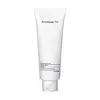What's inside
What's inside
 Key Ingredients
Key Ingredients

No key ingredients
 Benefits
Benefits

 Concerns
Concerns

 Ingredients Side-by-side
Ingredients Side-by-side

Saposhnikovia Divaricata Root Extract
AntimicrobialGlycerin
HumectantMyristic Acid
CleansingLauric Acid
CleansingPotassium Hydroxide
BufferingWater
Skin ConditioningPalmitic Acid
EmollientStearic Acid
CleansingGlycol Distearate
EmollientGlyceryl Stearate
EmollientGlyceryl Stearate Se
EmulsifyingPEG-100 Stearate
1,2-Hexanediol
Skin ConditioningButylene Glycol
HumectantGlyceryl Caprylate
EmollientOzokerite
Emulsion StabilisingHydrogenated Vegetable Oil
EmollientBeeswax
Emulsion StabilisingSodium Chloride
MaskingStearyl Stearate
EmollientHydrogenated Palm Acid
Capric Acid
CleansingOleic Acid
EmollientSodium Polyacrylate
AbsorbentCocamidopropyl Betaine
CleansingParfum
MaskingLinalool
PerfumingLimonene
PerfumingSaposhnikovia Divaricata Root Extract, Glycerin, Myristic Acid, Lauric Acid, Potassium Hydroxide, Water, Palmitic Acid, Stearic Acid, Glycol Distearate, Glyceryl Stearate, Glyceryl Stearate Se, PEG-100 Stearate, 1,2-Hexanediol, Butylene Glycol, Glyceryl Caprylate, Ozokerite, Hydrogenated Vegetable Oil, Beeswax, Sodium Chloride, Stearyl Stearate, Hydrogenated Palm Acid, Capric Acid, Oleic Acid, Sodium Polyacrylate, Cocamidopropyl Betaine, Parfum, Linalool, Limonene
Water
Skin ConditioningSodium Methyl Oleoyl Taurate
CleansingAcrylates Copolymer
Glycerin
HumectantDisodium Cocoamphodipropionate
CleansingDimethyl Sulfone
SolventPyridoxine Hcl
Skin ConditioningSalix Alba Bark Extract
AstringentForsythia Suspensa Fruit Extract
AntioxidantButylene Glycol
HumectantCentella Asiatica Extract
CleansingPolygonum Cuspidatum Root Extract
AntioxidantScutellaria Baicalensis Root Extract
AstringentCamellia Sinensis Leaf Extract
AntimicrobialChamomilla Recutita Flower Extract
MaskingRosmarinus Officinalis Leaf Extract
AntimicrobialSodium Chloride
MaskingCopper Tripeptide-1
Skin ConditioningAllantoin
Skin ConditioningCitric Acid
BufferingDisodium EDTA
Cocamidopropyl Betaine
CleansingPEG-75
HumectantPEG-120 Methyl Glucose Dioleate
EmulsifyingGlycyrrhiza Glabra Root Extract
BleachingPotassium Hydroxide
BufferingHydroxyacetophenone
AntioxidantEthylhexylglycerin
Skin ConditioningWater, Sodium Methyl Oleoyl Taurate, Acrylates Copolymer, Glycerin, Disodium Cocoamphodipropionate, Dimethyl Sulfone, Pyridoxine Hcl, Salix Alba Bark Extract, Forsythia Suspensa Fruit Extract, Butylene Glycol, Centella Asiatica Extract, Polygonum Cuspidatum Root Extract, Scutellaria Baicalensis Root Extract, Camellia Sinensis Leaf Extract, Chamomilla Recutita Flower Extract, Rosmarinus Officinalis Leaf Extract, Sodium Chloride, Copper Tripeptide-1, Allantoin, Citric Acid, Disodium EDTA, Cocamidopropyl Betaine, PEG-75, PEG-120 Methyl Glucose Dioleate, Glycyrrhiza Glabra Root Extract, Potassium Hydroxide, Hydroxyacetophenone, Ethylhexylglycerin
 Reviews
Reviews

Ingredients Explained
These ingredients are found in both products.
Ingredients higher up in an ingredient list are typically present in a larger amount.
Butylene Glycol (or BG) is used within cosmetic products for a few different reasons:
Overall, Butylene Glycol is a safe and well-rounded ingredient that works well with other ingredients.
Though this ingredient works well with most skin types, some people with sensitive skin may experience a reaction such as allergic rashes, closed comedones, or itchiness.
Learn more about Butylene GlycolCocamidopropyl Betaine is a fatty acid created by mixing similar compounds in coconut oil and dimethylaminopropylamine, a compound with two amino groups.
This ingredient is a surfactant and cleanser. It helps gather the dirt, pollutants, and other impurities in your skin to be washed away. It also helps thicken a product and make the texture more creamy.
Being created from coconut oil means Cocamidopropyl Betaine is hydrating for the skin.
While Cocamidopropyl Betaine was believed to be an allergen, a study from 2012 disproved this. It found two compounds in unpure Cocamidopropyl Betaine to be the irritants: aminoamide and 3-dimethylaminopropylamine. High-grade and pure Cocamidopropyl Betaine did not induce allergic reactions during this study.
Learn more about Cocamidopropyl BetaineGlycerin is already naturally found in your skin. It helps moisturize and protect your skin.
A study from 2016 found glycerin to be more effective as a humectant than AHAs and hyaluronic acid.
As a humectant, it helps the skin stay hydrated by pulling moisture to your skin. The low molecular weight of glycerin allows it to pull moisture into the deeper layers of your skin.
Hydrated skin improves your skin barrier; Your skin barrier helps protect against irritants and bacteria.
Glycerin has also been found to have antimicrobial and antiviral properties. Due to these properties, glycerin is often used in wound and burn treatments.
In cosmetics, glycerin is usually derived from plants such as soybean or palm. However, it can also be sourced from animals, such as tallow or animal fat.
This ingredient is organic, colorless, odorless, and non-toxic.
Glycerin is the name for this ingredient in American English. British English uses Glycerol/Glycerine.
Learn more about GlycerinPotassium hydroxide is commonly known as caustic potash. It is used to fix the pH of a product or as a cleaning agent in soap. In cleansers, it is used for the saponification of oils.
Sapnification is the process of creating fatty acid metal salts from triglycerides and a strong base. During this process, Potassium Hydroxide is used up and is not present in the final product.
Using high concentrations of Potassium Hydroxide have shown to irritate the skin.
Learn more about Potassium HydroxideChances are, you eat sodium chloride every day. Sodium Chloride is also known as table salt.
This ingredient has many purposes in skincare: thickener, emulsifier, and exfoliator.
You'll most likely find this ingredient in cleansers where it is used to create a gel-like texture. As an emulsifier, it also prevents ingredients from separating.
There is much debate on whether this ingredient is comedogenic. The short answer - comedogenic ratings don't tell the whole story. Learn more about comegodenic ratings here.
The concensus about this ingredient causing acne seems to be divided. Research is needed to understand if this ingredient does cause acne.
Scrubs may use salt as the primary exfoliating ingredient.
Learn more about Sodium ChlorideWater. It's the most common cosmetic ingredient of all. You'll usually see it at the top of ingredient lists, meaning that it makes up the largest part of the product.
So why is it so popular? Water most often acts as a solvent - this means that it helps dissolve other ingredients into the formulation.
You'll also recognize water as that liquid we all need to stay alive. If you see this, drink a glass of water. Stay hydrated!
Learn more about Water